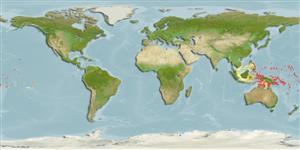Common names from other countries
>
Ovalentaria/misc (Various families in series Ovalentaria) >
Pomacentridae (Damselfishes) > Pomacentrinae
Etymology: Amphiprion: Greek, amphi = on both sides + Greek, prion, -onos = saw (Ref. 45335).
More on author: Cuvier.
Environment: milieu / climate zone / depth range / distribution range
Ökologie
seewasser riff-verbunden; standorttreu; tiefenbereich 0 - 40 m (Ref. 89972). Tropical; 15°N - 15°S
Pacific Ocean: Queensland, Australia and New Guinea to the Marshall and Tuamoto islands.
Length at first maturity / Size / Gewicht / Alter
Maturity: Lm 7.5, range 7 - 8 cm
Max length : 17.0 cm TL Männchen/unbestimmt; (Ref. 9710)
Rückenflossenstacheln (insgesamt): 10 - 11; Rückenflossenweichstrahlen (insgesamt): 15-17; Afterflossenstacheln 2; Afterflossenweichstrahlen: 13 - 14.
Adults inhabit passages and outer reef slopes. Known to occur at 25°C. Feed chiefly on planktonic copepods, algae, echiuroid and sipunculoid worms, and pelagic tunicates. Oviparous, distinct pairing during breeding (Ref. 205). Eggs are demersal and adhere to the substrate (Ref. 205). Males guard and aerate the eggs (Ref. 205). Associated with the anemones: Entacmaea quadricolor, Heteractis aurora, Heteractis crispa, Heteractis magnifica, Stichodactyla haddoni, and Stichodactyla mertensii (Ref. 5911). Minimum depth reported taken from Ref. 128797.
Oviparous, distinct pairing during breeding (Ref. 205). Eggs are demersal and adhere to the substrate (Ref. 205). Males guard and aerate the eggs (Ref. 205). Spawning pairs can be found throughout the year. The total annual egg production is estimated at 3,000 - 5,000 eggs (Ref. 237). Fecundity ranges from 128 - 632 (Ref. 237). Also Ref. 7471, 240.
Fautin, D.G. and G.R. Allen, 1992. Field guide to anemonefishes and their host sea anemones. Western Australian Museum, Francis Street, Perth. (Ref. 5911)
IUCN Rote Liste Status (Ref. 130435)
CITES (Ref. 128078)
Not Evaluated
Bedrohung für Menschen
Harmless
Nutzung durch Menschen
Fischereien: kleinfischerei; Aquarium: Kommerziell
Mehr Information
ReferenzenAquakulturAquakultur ProfilZuchtlinienGenetikElectrophoresesVererbbarkeitKrankheitenVerarbeitungMass conversion
Tools
Zusatzinformationen
Download XML
Internet Quellen
Estimates based on models
Preferred temperature (Ref.
115969): 27.2 - 29, mean 28 (based on 146 cells).
Phylogenetic diversity index (Ref.
82804): PD
50 = 0.5000 [Uniqueness, from 0.5 = low to 2.0 = high].
Bayesian length-weight: a=0.02344 (0.01149 - 0.04783), b=2.99 (2.82 - 3.16), in cm Total Length, based on LWR estimates for this (Sub)family-body shape (Ref.
93245).
Trophic level (Ref.
69278): 2.2 ±0.0 se; based on diet studies.
Widerstandsfähigkeit (Ref.
120179): hoch, Verdopplung der Population dauert weniger als 15 Monate. (tm<1; Fec=128-632).
Fishing Vulnerability (Ref.
59153): Low vulnerability (16 of 100).
